This guide is designed to help learner drivers understand the basics of the most common road markings throughout the UK.
Why Are Road Markings Important?
Road markings are used to maintain the control of traffic, parking regulations and to enable the safety of all road users, including pedestrians, animals and properties.
Stop And Give Way Road Markings
 |
Stop Line At Signals
One of the most recognisable road markings for drivers in the UK, the “Stop” line is something everyone has to adhere to. This Stop line is thinner than the typical road marking that is located near a Stop sign. This road line is also used for Police control areas. |
 |
Stop Line At Sign
This line is thicker than the ones you will find at signals or Police control areas. These lines are located next to Stop signs and you must come to a complete stop before crossing.
|
 |
Give Way To Traffic (Roundabout)
Typically, this road marking is found at medium to large roundabouts. This line is to tell you that you must give way to traffic from the right of a roundabout.
|
 |
Give Way To Traffic (Mini-Roundabout)
A shorter, fatter pattern of lines to tell you to give way to traffic from the right. Located on mini-roundabouts, this line is a more condensed version of one you would find on a larger roundabout. |
 |
Give Way Lines (Major Road)
Located at the end of a road, leading onto another road – the give way lines are there for your safety. Upon approaching the lines, take caution and give way to oncoming traffic. There’s no need to come to a complete stop here unless it’s unsafe to continue. |
Carriageway Road Markings
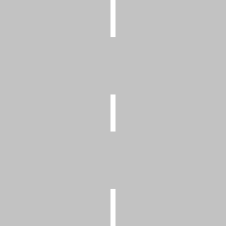 |
Broken White Lines On A Carriageway
The broken white line marks the centre of the road for drivers. When the lines are shorter and the gaps are longer, this indicates it’s safer to cross the lines (to overtake or turn). Do not cross these lines if it would put you or others in danger. |
 |
Broken White Lines On A Carriageway (Hazard)
When the broken white lines on a carriageway become longer and the gap between them shortens, this indicates a hazard is near. Usually this will happen when approaching slip-roads, when junctions pose a hazard to drivers or when traffic is merging. |
 |
Lane Dividers On A Carriageway
Short road lines spaced far away used to create lanes. Stay within the lines and only overtake when it is safe to do so.
|
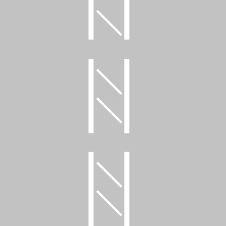 |
Carriageway Areas With White Diagonal Stripes
Areas of white diagonal stripes or chevrons painted on the road. These are to separate traffic lanes or to protect traffic turning right. If the area is surrounded by broken white lines, do not enter that area unless absolutely necessary. If the area is marked with chevrons and bordered by solid white lines you MUST NOT enter it except in an emergency. |
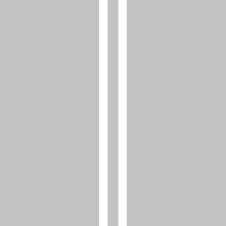 |
Double White Lines On A Carriageway (Unbroken)
Double white lines where the line nearest you is solid. This means you MUST NOT cross or straddle it unless it is safe and you need to enter adjoining premises or a side road. You may cross the line if necessary, provided the road is clear, to pass a stationary vehicle, or overtake a pedal cycle, horse or road maintenance vehicle, if they are travelling at 10 mph (16 km/h) or less. |
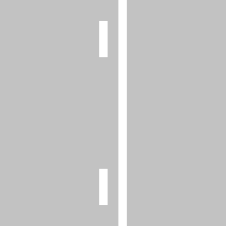 |
Double White Lines On A Carriageway (Broken)
If you see double white lines in the middle of the road and the side closest to you is “broken”, you are allowed to cross over to ordertake. You must be able to get back before that line becomes unbroken again. Arrow lines will indicate that you need to get back over to your lane. |
 |
Carriageway Edge Line
A single white line that runs along the edge of a carriageway. This helps drivers stay clear of the side of the road, allowing a safer journey for everyone. Some edge lines will be fitted with “raised ribs” or rumble strips to alert drivers if they are straddling close to the edge. |
Carriageway Restrictions
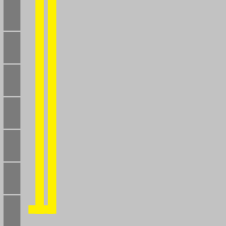 |
No Waiting At Any Time
Solid yellow lines indicate you cannot park or wait. You are allowed to pull-over and stop to allow passengers to board or alight. |
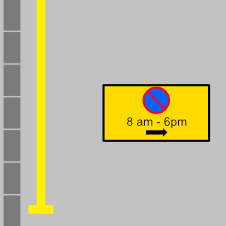 |
No Waiting During Times Shown On A Sign
A single solid yellow line means you are not to wait or load/unload during the times shown on a sign. If there is no sign then the rules are in force everyday including Sundays and Bank Holidays. |
 |
No Loading At Any Time
Indicated by two yellow lines painted onto the kerb, these show you cannot load or unload at any time.
|
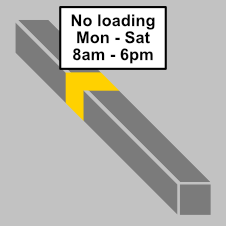 |
No Loading / Unloading During The Time Shown
Loading and unloading is permitted outside of the times shown. You cannot park here unless you are loading or unloading. |
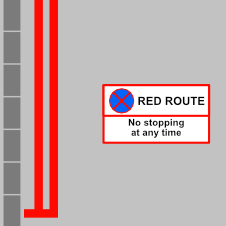 |
Red Route – No Stopping At Any Time
You cannot stop at any time with these road markings. You are not permitted to stop, load, unload or drop passengers off here unless you are a licensed taxi or a blue badge holder. |
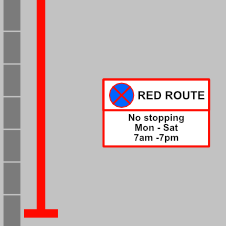 |
No Stopping During Times Shown
A single solid red line accompanied with signage means you cannot stop within the stated times. Single lines are only a guide and you must consult nearby signs to confirm. |
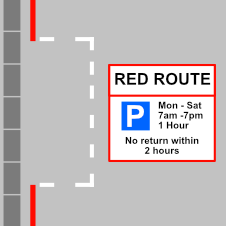 |
Parking Is Limited To Specified Duration
Here you are permitted to park within the days and times shown. The length of stay is stated on a nearby sign and you may not be allowed to return within a certain time frame. |
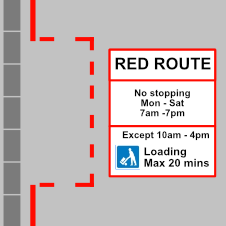 |
Only Loading Can Take Place At The Times Shown
Red bays indicate they can be used for parking within specific times. Some bays will allow loading or unloading for a certain length of time.
|
Author: Dean Michael

is it illegal for someone to stop dead on a 60mph A road ( with a single white line in the middle of the road ) to turn off to the right to a drive way when there is a lot of traffic behind them ( and on a bend too )
Ha! Thank you for helping settle a debate!
Hazard warning lines are longer and have less space between them to indicate an upcoming hazard!
We’ve been arguing about this for the last 20mins along the A34 :D